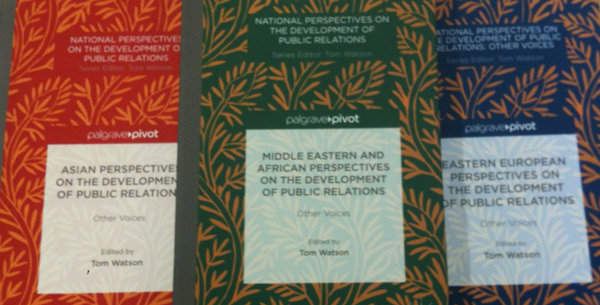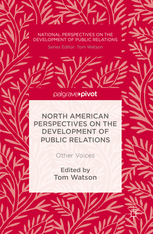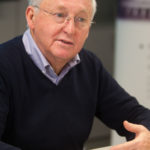
One of the delightful developments from the International History of Public Relations Conference (IHPRC) and growing interest in the antecedents of the field is the publication of some wonderful books. In particular, two series have gone from strength to strength.
The first is the collection of scholarly texts edited by Kevin Moloney: New Directions in Public Relations and Communication Research. Their popularity among the academic community is such that the excellent Gender and Public Relations is due out in paperback on 31 July 2016; which I trust will encourage more PR practitioners to engage with the critical perspectives on voice, image and identity, that the books range of chapters covers. This series grew out of conversations between the publishers and Kevin at IHPRC initially, and subsequent ideas proposed by authors/editors who presented their work as IHPRC papers over the past seven years.
 The second special collection: National Perspectives on the Development of Public Relations: Other Voices, edited by Professor Tom Watson offer an amazing array of authentic world-wide views of the history of public relations freed from the corporatist Anglo-American framework that dominated understanding of the heritage of the field prior to IHPRC unleashing an unprecedented interest among an expanding body of public relations historians.
The second special collection: National Perspectives on the Development of Public Relations: Other Voices, edited by Professor Tom Watson offer an amazing array of authentic world-wide views of the history of public relations freed from the corporatist Anglo-American framework that dominated understanding of the heritage of the field prior to IHPRC unleashing an unprecedented interest among an expanding body of public relations historians.
The publication on 2 September 2016 of North American Perspectives on the Development of Public Relations, concludes the seven-volume series, which is accompanied by an eighth book offering hugely valuable essays on new and revised historiographical and theoretical approaches. Ahead of its launch, in our final PR Conversations History Week post, Tom reflects on his work in redefining the dimensions of PR history in 350,000 words.
From fruitcake to iced cupcake
Images of cooking are ‘front of mind’ when writing about my experiences in commissioning and editing a series of books on the history of public relations. First, I thought of a large fruitcake in which all the ingredients were placed in a bowl and mixed together. That was wrong as there would only be one large cake, and there are seven books in the series. Next, I weighed up enticing images of plates of Spanish tapas or an Asian meal comprising small piquant dishes. Finally, I settled on the home baker’s favourite, the iced cupcake. All are the same shape but every one is subtly different with icing and decorations, and each is hand-made.
So the history of PR can be expressed in an edible form. If only it was so easy. The seven books have a total of 60 chapters plus Introductions, Series Preface and Indexes. Making 60 cup cakes takes few hours. Seven books have taken 27 months.
Proposal
The editorial journey began in July 2013 when I first discussed the book proposal with the publisher, Palgrave Macmillan. It was to be a different approach to previous histories of public relations, which, with few exceptions tell a repetitive story that PR was invented in the USA and introduced to the world. However, as scholarship has developed recently, the story of how PR appeared in many different forms has emerged. There is not one ‘PR’ but many. Also, I wanted the series to have a more authentic style with chapters from nationally or regionally based authors who eschewed the use of North American frames of reference in favour of local archival and oral history research.
The series was titled as National Perspectives on the Development of Public Relations: Other Voices. The books were, in order of publication: Asia (including Australasia), Eastern Europe, Middle East and Africa, Latin America and Caribbean, Western Europe, essays on historiography (the writing and theorization of history) and North America, to be published in August. Although there was some debate of the use of “Development” in the title, I considered that the PR sector in all its forms has developed in the past 150 years but not always in the linear, upward path that progressivist authors have claimed.
Authors
My next step was to recruit authors. Each book would have 10 chapters of 4000 words each plus references. There were also word counts for the editor in the Preface, Introduction, Index and other publisher information. For the North American Perspectives volume, the chapters were slightly longer at 4750 words.
Fortunately, I knew many potential authors personally or we had heard of each other. Others, such as in Latin America, had to be tracked down through friendly academics who knew someone who had met someone at a conference. In the first five books, there was at least one country for which there was difficulty in identifying the right person. The fastest acceptance was 10 minutes from dispatch of an email when a Singaporean author was looking at her computer around midnight and Skyped me immediately to discuss the project.
Editor role
As the series was to be written in academic yet readable English, and many authors were not native English speakers, the editor’s role was very important. Some authors had studied and worked in the UK, North America or Commonwealth countries but many relied on colleagues and translators when writing academic material.
It was an inter-dependent relationship. The standard of historical research and writing had to be of very good international standard, yet each book needed chapters submitted on time. So my relationship with authors was as friendly mentor and editor: firm when I needed to be but always encouraging.
Only one chapter was rejected outright. Despite two editor’s revisions, the author just wouldn’t accept basic academic standards of referencing to support assertions. Four other authors didn’t produce chapters on time, even after extensive extensions. Two of them just disappeared and no further email or other contact was received. Luckily, I was able to replace one elusive author with a regional expert academic who had written to me when he had read about the series’ first book.
Problems
Other chapters to cause surprise and “grief” included a European author who submitted a chapter without any references to support the story being told. As this person was the ‘expert’ on that country, their view was that no source material was needed. OK, I said, no sources means no chapter. After a tense wait with deadline approaching, references were added and the chapter accepted, but there was a strong chance that a replacement author would be needed.
Historians aren’t expected to be mathematical geniuses but some struggled with the 4000 word limit in the first five books. Submitted chapter lengths ranged from 3000 to 7500 words. Some Latin American authors were upset when told that 3500 words had to be taken from their chapter. I aided the process by proposing changes. They further edited the chapter and weren’t happy at the time but were pleased with the published result.
One chapter from Latin America illustrated the problems of thinking in one language and writing in another. I just couldn’t understand what the author was trying to say in parts of it. Fortunately, a Spanish academic was visiting my university and researching archives for her chapter for a later book in the series. If the text defeated me, she re-imagined it into Spanish sentence structures, which answered some questions. But some sections defeated us. My solution was to rewrite them and propose revisions to the author who, happily for me, accepted them with minor changes.
Although native English speakers should be very proficient, it wasn’t always the case. Some chapters needed as much work as those for whom English is a third or fourth language. That’s a teeth-grinding annoyance for editors.
The outcome of 27 months’ effort is that 94 authors wrote 60 chapters that include the histories of 75 countries in seven books, totaling around 350,000 words. And we are all on friendly terms. That’s a multiple achievement.
 Tom Watson is Emeritus Professor in the Faculty of Media & Communication at Bournemouth University in England. He is founder of the International History of Public Relations Conference and an active historian. The series that he edited, National Perspectives on the Development of Public Relations: Other Voices, is published by Palgrave Macmillan.
Tom Watson is Emeritus Professor in the Faculty of Media & Communication at Bournemouth University in England. He is founder of the International History of Public Relations Conference and an active historian. The series that he edited, National Perspectives on the Development of Public Relations: Other Voices, is published by Palgrave Macmillan.
- An earlier version of this article was published in Viestijat (viestijat.fi), the online magazine of PROCOM, Finland.
This is the fifth and final post in the PR Conversations inaugural History Week. See links below to all five posts:
Part 1: Made by history – a book collector’s story by Heather Yaxley
Part 2: The Museum of Public Relations – archives and artefacts under the gaze of Bernays (and Lee and Page and Byoir…) with thanks to Shelley Spector, and Adrian Crookes
Part 3: PR History – prospecting for archival gold by Tom Watson
Part 4: Conducting historical interviews in a transparent age by Heather Yaxley
Part 5: The dimensions of PR history: 60 x 75 x 94 x 350,000 by Tom Watson
